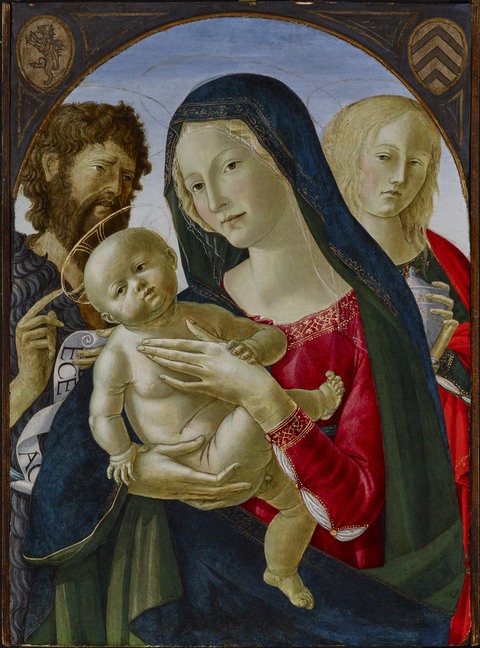Marks, Inscriptions, and Distinguishing Features
Inscription: On the scroll held by St. John the Baptist: “ECE…A” (abbreviation for “Ecce Agnus Dei,” or “Behold the Lamb of God”).
Distinguishing features: Two escutcheons in the spandrels in the upper corners. In the upper left: a lion, outlined in black and with its claws, tongue, and genitalia accented in red, standing on its hind legs and facing the right. In the upper right: a three-chevron design in alternating white (now darkened) and brown.
Entry
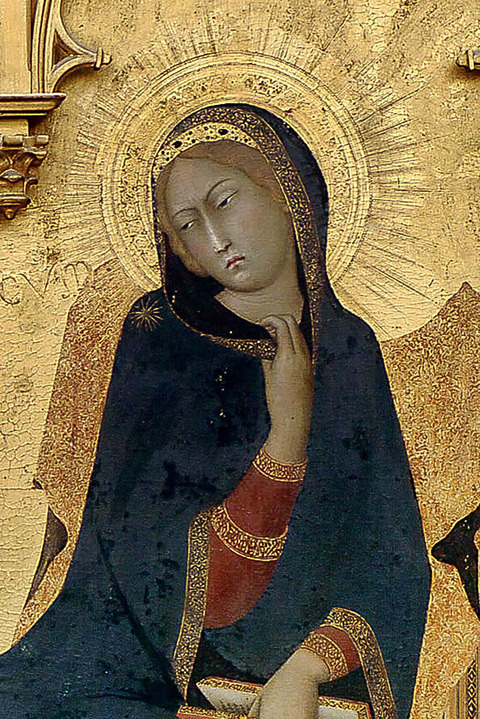
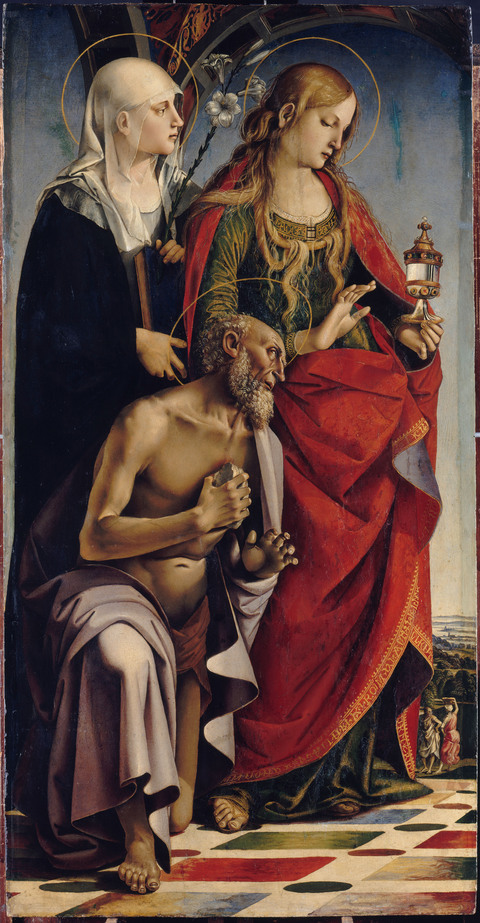

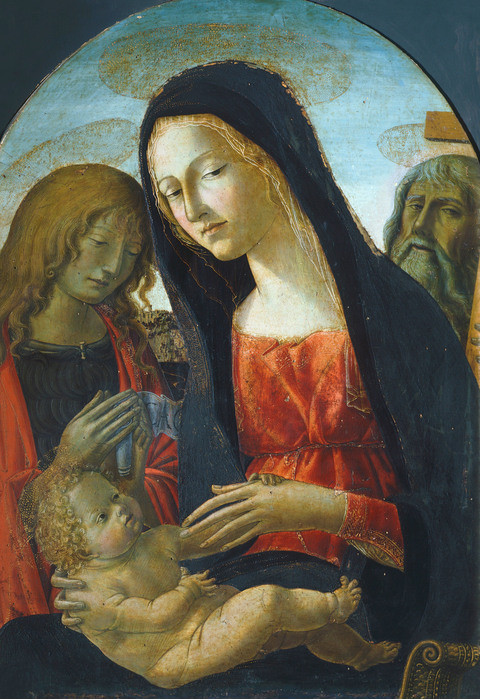
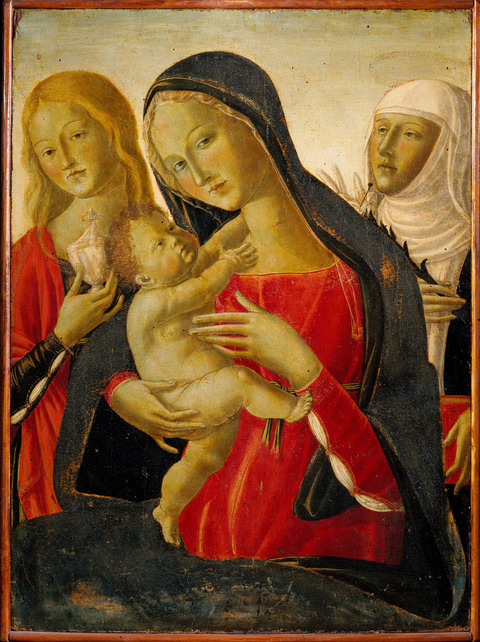
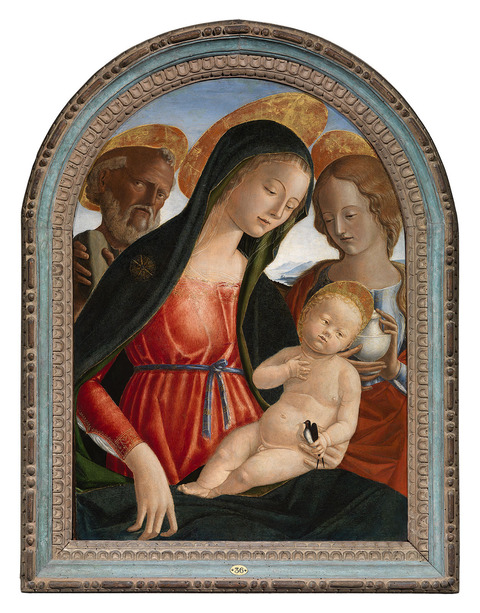
Author
Provenance
Probably Counts Chigi-Saracini, Siena, by 1819.27
László (Ladislaus) Károlyi, Budapest, by 1913.28
(E. and A. Silberman Galleries, New York);
G.H.A. Clowes, Indianapolis, by 1939;29
The Clowes Fund, Indianapolis, from 1958–2004, and on long-term loan to the Indianapolis Museum of Art since 1971 (C10058);
Given to the Indianapolis Museum of Art, now the Indianapolis Museum of Art at Newfields, in 2004 (2004.161).
Exhibitions
Szépműveszéti Muzéum, Budapest, mid-to-late 1910s, on loan;30
World’s Fair, New York, 1939, Masterpieces of Art, no. 265;
California Palace of the Legion of Honor and the M.H. De Young Memorial Museum, San Francisco, 1940, Seven Centuries of Painting, no. L-8;
John Herron Art Museum, Indianapolis, 1944, on loan;
The Spanish Institute, New York, 1955, An Exhibition of Paintings for the Benefit of the Research Fund of Art and Archaeology, no. 7;
John Herron Art Institute, Indianapolis, 1959, Paintings from the Collection of George Henry Alexander Clowes: A Memorial Exhibition, no. 42;
The Art Gallery, University of Notre Dame, Notre Dame, IN, 1962, A Lenten Exhibition, no. 37;
Indiana University Art Museum, Bloomington, 1962, Italian and Spanish Paintings from the Clowes Collection, no. 8;
Guangdong Museum, Guangzhou, China; Hunan Museum, Changsha, China; Chengdu Museum; 2020–2021, Rembrandt to Monet: 500 Years of European Painting.
References
Galgano de' Saracini, Relazione in compendio delle cose più notabili nel Palazzo e Galleria Saracini di Siena (Siena: Palazzo Chigi Saracini, 1819), 66;
Bernard Berenson, The Central Italian Painters of the Renaissance (New York and London: G.P. Putnam’s Sons, 1897), 157;
William Heywood and Lucy Olcott, Guide to Siena (London: T.F. Unwin, 1903), 222–223;
Emil Jacobsen, Das Quattrocento in Siena: Studien in der Gemäldegalerie der Akademie (Strasbourg: J.H. Ed. Heitz, 1908), 83, pl. XLIX, fig. 2;
Bernard Berenson, The Central Italian Painters of the Renaissance, 2nd ed. (New York and London: Putnam, 1909), 207;
Pietro Rossi, “Neroccio di Bartolommeo Landi e la sua più grande tavola,” Rassegna d’arte senese 5 (1909): 30;
Mary Berenson Logan, “Madonne di Neroccio dei Landi,” Rassegna d’arte 13 (1913): 73 (reproduced);
Luigi Dami, “Neroccio di Bartolommeo Landi,” Rassegna d’Arte 13 (1913), 164 (reproduced fig. 14);
John Archer Crowe and Giovanni Battista Cavalcaselle, A History of Painting in Italy, ed. Robert Langton Douglas and Tancred Borenius (London: John Murray, 1914), 5:159n6;
Casimir Chledowski, Siena (Berlin: B. Cassirer, 1923), 2:225;
William Heywood and Lucy Olcott, Guide to Siena (Siena: Libreria Editrice Siena, 1924), 251;
Paul Schubring. “Landi, Neroccio di Bartolomeo dei,” in Ulrich Thieme and Felix Becker, eds., Allgemeines Lexicon der Bildenden Künstler von Antike bis zur Gegenwart, 37 vols. (Leipzig: Seemann, 1907–1950), 22 (1928): 295;
Bernard Berenson, Italian Pictures of the Renaissance (Oxford: Clarendon Press, 1932), 338–390;
Bernard Berenson, Pitture italiane del Rinascimento (Milan: Hoepli, 1936), 335;
Raimond van Marle, The Development of the Italian Schools of Painting, 19 vols. (The Hague: Nijhoff, 1923–1938), 16 (1937): 312;
George Henry McCall and Wilhelm Valentiner, Catalogue of European Paintings and Sculpture from 1300–1800: Masterpieces of Art, New York World’s Fair, May to October 1939, exh. cat. (New York: Publishers Print Co., 1939), 128–129, no. 265 (reproduced);
Seven Centuries of Painting, exh. cat. (San Francisco: California Palace of the Legion of Honor and the M.H. De Young Memorial Museum, 1939), 30 (reproduced fig. L-8).
Cesare Brandi, Quattrocentisti senesi (Milan: Hoepli, 1949), 272;
Edna Perkel, An Exhibition of Paintings for the Benefit of the Research Fund of Art and Archaeology: The Spanish Institute, Inc., October 12 to November 1, 1955, exh. cat. (New York: E. & A. Silberman Galleries, 1955): 19;
Paintings from the Collection of George Henry Alexander Clowes: A Memorial Exhibition, exh. cat. (Indianapolis: John Herron Art Museum, 1959), no. 42;
Gertrude Coor, Neroccio de’ Landi 1447–1500 (Princeton, NJ: Princeton University Press, 1961), 103–104, 169–170 (reproduced fig. 87);
Mark Roskill, “Clowes Collection Catalogue” (unpublished typed manuscript, IMA Clowes Archive, Indianapolis Museum of Art, Indianapolis, IN, 1968);
Anthony F. Janson and A. Ian Fraser, 100 Masterpieces of Painting: Indianapolis Museum of Art (Indianapolis: Indianapolis Museum of Art, 1980), 38–39 (reproduced);
Laurence Kanter in Keith Christiansen, Laurence B. Kanter, and Carl Brandon Strehlke, eds., Painting in Renaissance Siena 1420–1500, exh. cat. (New York: Metropolitan Museum of Art, 1988), 334;
Genetta Gardner, “Landi (del Poggio), Neroccio (di Bartolommeo di Benedetto) de',” in Jan Turner, ed., The Dictionary of Art (Oxford: Oxford University Press, 1996), 18:98;
Joan M. Hartman, Indianapolis Museum of Art: Highlights of the Collections (Indianapolis: Indianapolis Museum of Art, 2005), 91;
Luke Syson in Luciano Bellosi, ed., La Collezione Salini: Dipinti, sculture e oreficerie dei secoli XII, XIII, XIV e XV (Florence: Centro di, 1988), 1:342;
Carlo Del Bravo, “Significati d’opere di Neroccio,” Artista (2008): 32;
Stefano G. Casu, The Pittas Collection: Early Italian Paintings (1200–1530) (Florence: Mandragora, 2011), 174;
Kjell M. Wangensteen et al., Rembrandt to Monet: 500 Years of European Painting (Nanjing: Jiangsu Phoenix Literature and Art Publishing, 2020), 34–37 (reproduced);
Kjell M. Wangensteen et al., Floating Lights and Shadows: 500 Years of European Painting (Nanjing: Jiangsu Phoenix Literature and Art Publishing, 2020), 34–37 (reproduced).
Technical Notes and Condition
The painting is composed of a single, arched-top poplar panel that has a slight, convex warp. The spandrels are not original to the picture and were added at a later date, sometime after 1908. The panel retains its original thickness and, despite some insect damage, is in a generally good state. The paint surface is in a fairly good state, though there are some prominent losses (now filled) including an “X” shaped scratch extending across the Madonna’s face and cheek, and a two-part loss in John the Baptist’s hands. The Madonna’s blue robe shows extensive losses and has darkened with age. In addition, most of the mordant gilding of the figures' halos, the Magdalen’s hairnet and pyx, and the figures' garments has been lost, with the notable exception of the hems of the Virgin’s red robe and most of the Christ child’s halo. The contours of the Madonna and Child were incised into the gesso ground; the saints and the rest of the Madonna and Child were then drawn in with a fluid, liquid-based medium, some of which can be seen with the naked eye thanks to the artists' characteristic application of translucent paint layers. Pentimenti are visible in the contour of the Madonna’s head, the child’s proper left cheek, and his proper right index finger. That only the central figures were incised into the gesso ground suggests that they were begun first, perhaps even before the saints' identities were selected by the patron.
Notes
-
The attribution to Neroccio is due to Bernard Berenson, The Central Italian Painters of the Renaissance (New York and London: G. P. Putnam’s Sons, 1897), 157. The painting had earlier been assigned to Matteo di Giovanni; see Galgano de' Saracini, Relazione in compendio delle cose più notabili nel Palazzo e Galleria Saracini di Siena (Siena: Palazzo Chigi Saracini, 1819), 66. The authoritative work on Neroccio remains Gertrude Coor, Neroccio de’ Landi 1447–1500 (Princeton, NJ: Princeton University Press, 1961). For the most recent biographical overview of the artist, see Dóra Sallay, Corpus of Sienese Paintings in Hungary 1420–1510 (Florence: Centro Di, 2015), 178–179. ↩︎
-
Max Seidel, “The ‘Societas in arte pictorum’ of Francesco di Giorgio and Neroccio de' Landi,” in Max Seidel, ed., Italian Art of the Middle Ages and the Renaissance (Venice: Marsilio, 2005), 537–558. ↩︎
-
There has been much confusion about Neroccio’s work in Lucca. It was long thought that he completed two works for the city: a large polychrome wooden sculpture, Death and Assumption of the Virgin, begun by Vecchietta in 1477 and completed by Neroccio in 1481 (now in a fragmentary state at Lucca, Museo Nazionale di Villa Guinigi); and a now-lost altarpiece of unknown subject, commissioned by Giannino Bernardi, abbot of San Salvatore a Sesto a Moriano, in 1481. A predella with Scenes from the Life of St. Benedict (Florence, Gallerie degli Uffizi, inv. 1890 no. 1602) has occasionally been identified as belonging to this last work. It has, however, recently been established that Neroccio made only one work for Lucca, and the Bernardi commission is actually the Death and Assumption of the Virgin begun by Vecchietta. Bernardi commissioned this work for the high altar of Santa Maria del Corso in the Lucchese environs. For further information, see Francesco Caglioti, “Il Vecchietta, Neroccio e l'Assunta per l’altar maggiore di Sana Maria del Corso a Lucca,” Studi di Memofonte 20 (2018): 1–44. ↩︎
-
Neroccio’s work for the duke is now lost. For the documents, see Gertrude Coor, Neroccio de’ Landi 1447–1500 (Princeton, NJ: Princeton University Press, 1961), 144–145. ↩︎
-
In addition to the 32 examples catalogued in Gertrude Coor, Neroccio de’ Landi 1447–1500 (Princeton, NJ: Princeton University Press, 1961), see the panels in Chambéry (Musée des Beaux-Arts, inv. D.81-1-5), Dijon (Musée des Beaux-Arts, inv. 4028), Limassol (Pittas Collection), and formerly London (art market; photo: Fototeca Zeri, no. 44611). ↩︎
-
Luke Syson, “Modernising the Tradition,” in Luke Syson, ed., Renaissance Siena: Art for a City (London: National Gallery, 2007), 106–107. ↩︎
-
Stephen J. Campbell and Stephen J. Milner, “Art, Identity, and Cultural Translation in Renaissance Italy,” in Stephen J. Campbell and Stephen J. Milner, eds., Artistic Exchange and Cultural Translation in the Italian Renaissance City (Cambridge: Cambridge University Press, 2004), 5. For further information, see Keith Christiansen, Laurence B. Kanter, and Carl Brandon Strehlke, eds., Painting in Renaissance Siena 1420–1500 (New York: Metropolitan Museum of Art, 1988); Luke Syson, ed., Renaissance Siena: Art for a City (London: National Gallery, 2007); and Gabriele Fattorini, “La lezione trecentesca e le immagini dell’identità civica,” in Max Seidel, ed., Da Jacopo della Quercia a Donatello (Milan: Motta, 2010), 142–147. ↩︎
-
Bernard Berenson, The Central Italian Painters of the Renaissance (London: G. P. Putnam’s, 1909), 55–56. ↩︎
-
Luke Syson, “Stylistic Choices,” in Luke Syson, ed., Renaissance Siena: Art for a City (London: National Gallery, 2007), 53. ↩︎
-
On the Bichi altarpiece, see Luke Syson in Luke Syson, ed., Renaissance Siena: Art for a City (London: National Gallery, 2007), 222–225. ↩︎
-
For these works, see Thomas Henry and Laurence Kanter, Luca Signorelli: The Complete Paintings (Milan: Rizzoli, 2002), 181–182, 187. ↩︎
-
Gertrude Coor, Neroccio de’ Landi 1447–1500 (Princeton, NJ: Princeton University Press, 1961), 103. ↩︎
-
The painting was dated between 1492 and 1500 by both Luigi Dami, “Neroccio di Bartolommeo Landi,” Rassegna d’Arte 13 (1913): 164, and Raimond van Marle, The Development of the Italian Schools of Painting, 19 vols. (The Hague: Nijhoff, 1923–1938), 16 (1937): 312. Cesare Brandi, Quattrocentisti senesi (Milan: Hoepli, 1949), 272, narrowed the date to about 1496 because of the similarities to the Montisi altarpiece. ↩︎
-
For the Chigi-Saracini and Horne paintings, see Gertrude Coor, Neroccio de’ Landi 1447–1500 (Princeton, NJ: Princeton University Press, 1961), 105–106, 166, and 180. ↩︎
-
On Neroccio’s devotional imagery and his approach to iconography, see Carlo Del Bravo, “Significati d’opere di Neroccio,” Artista (2008): 28–33. ↩︎
-
The child’s unusual baldness was first pointed out by Gertrude Coor, Neroccio de’ Landi 1447–1500 (Princeton, NJ: Princeton University Press, 1961), 103. The only other bald Christ child by Neroccio that I have been able to find is in the Madonna and Child with Saints John the Baptist and Jerome (Gazzada Schianno, Villa Cagnola), which is roughly contemporary with the Clowes picture. The Cagnola painting is much abraded, and it seems the child may once have had tufts of hair that have since disappeared. ↩︎
-
A modified version of the pose recurs in the Madonna and Child with Saints Mary Magdalene and Catherine of Siena (see fig. 5). There the child seems to be climbing into his mother’s arms, and his genitals are less visible. ↩︎
-
For other pairings of the two saints in Siena, see the panels by Neroccio and his workshop (Utrecht, Museum Catharijneconvent, inv. ABM s21) or Bernardino Fungai (Siena, Pinacoteca, inv. 375). For a pairing in 1490s Florence, see Filippino Lippi’s Valori altarpiece for San Procolo (central panel formerly Berlin, Kaiser-Friedrich-Museum, inv. 96, destroyed 1945; side panels now Florence, Galleria dell’Accademia, inv. 1890 nos. 8651, 8653). For one in 1490s Lucca, see Sano Ciampanti’s so-called Heim altarpiece (sold, Sotheby’s, London, 8 December 1993, lot 5). ↩︎
-
The design of the Magdalene in the Clowes panel was reused in the Madonna and Child with Saints Sebastian and Catherine of Alexandria by Neroccio’s workshop (Frankfurt, Städel Museum, inv. 1007). In that painting she looks absentmindedly out of the picture field, and it is the Virgin who makes eye contact with the viewer. This difference suggests her engagement with the viewer of the Clowes panel is deliberate. ↩︎
-
In addition to the monastery of Santa Maria Maddalena near the Porta Tufi, discussed below, there was also the hospital church of Santa Maria Maddalena near the Porta Romana, which belonged to the Cistercians in the fifteenth century and is now destroyed. ↩︎
-
Syson made the observation specifically in relation to Neroccio’s Madonna and Child with Saints Paul and Mary Magdalen (Siena, Castello di Gallico, Salini Collection), where the Magdalene also flanks the Virgin and Child and looks out at the viewer; see Luke Syson in Luke Syson, ed., Renaissance Siena: Art for a City, exh. cat. (London: National Gallery, 2007), 122; and Luke Syson in Luciano Bellosi, ed., La Collezione Salini: Dipinti, sculture e oreficerie dei secoli XII, XIII, XIV e XV (Florence: Centro Di, 2009), 342. He further noted that the Clowes panel and Neroccio’s other Madonnas with the Magdalene seem to postdate the Nove’s return from exile in 1487 (see the paintings formerly at Brussels, Stoclet collection; Florence, Museo Horne, fig. 6; Limassol, Pittas Collection; Siena, Palazzo Chigi-Saracini; Utrecht, Museum Catharijneconvent, inv. ABM s21). Dóra Sallay, however, rightly noted that Neroccio could have had occasion to paint the Magdalene earlier in his career, given his connections to one of the Sienese convents dedicated to her; Dóra Sallay, Corpus of Sienese Paintings in Hungary 1420–1510 (Florence: Centro Di, 2015), 192n9. For more on the cult of the Magdalene in late fifteenth-century Siena, see Philippa Jackson, “The Cult of the Magdalen: Politics and Patronage under the Petrucci,” in Mario Ascheri, ed., L’ultimo secolo della Repubblica di Siena: Arti, cultura e società; Atti del convegno internazionale, Siena 28–30 settembre 2003 e 16–18 settembre 2004 (Siena: Accademia Senese degli Intronati, 2008), 391–403. ↩︎
-
For the contract for Neroccio’s altarpiece, see Gertrude Coor, Neroccio de’ Landi 1447–1500 (Princeton, NJ: Princeton University Press, 1961), 146–147. On the monastery and its novesco patronage, see Philippa Jackson, “The Cult of the Magdalen: Politics and Patronage under the Petrucci,” in Mario Ascheri, ed., L’ultimo secolo della Repubblica di Siena: Arti, cultura e società; Atti del convegno internazionale, Siena 28–30 settembre 2003 e 16–18 settembre 2004 (Siena: Accademia Senese degli Intronati, 2008), 395–400. ↩︎
-
Timothy J. Dickey, “An Undiscovered Sienese Lauda, Adoramus te, Christe, and the Provenance of Domenico di Bartolo’s Madonna of Humility (1433),” Explorations in Renaissance Culture 34 (2008): 93–94, 98. ↩︎
-
The original frame was probably similar to that of fig. 3: a simple gold band following the shape of the panel. The panel could have then been inserted into a larger and more elaborate tabernacle frame, such as the type on Sano di Pietro’s Madonna and Child with Angels and Saints (Siena, Pinacoteca, inv. 228), Neroccio’s Madonna and Child with Saints John the Baptist and Michael (Siena, Oratorio della Santissima Trinità), or Benvenuto di Giovanni’s Madonna and Child (New York, Metropolitan Museum of Art, inv. 1975.1.54). ↩︎
-
The Chigi emblem features a mountain with six golden peaks surmounted by an eight-pointed star. The Saracini emblem is the head of a Saracen beneath an eagle. After the families intermarried, these designs were combined. See Girolamo Gigli, Arme delle famiglie nobili di Siena che al presence si truovano, e godono, o possono godere gli onori del supremo eccelso maestrato (Siena: n.p., 1706). ↩︎
-
This assertion first appears in the dossier for the painting compiled by the Silberman Galleries, which sold the painting to the Clowes Collection. It was repeated in George Henry McCall and Wilhelm Valentiner, Catalogue of European Paintings and Sculpture from 1300–1800: Masterpieces of Art, New York World’s Fair, May to October 1939, exh. cat. (New York: Publishers Print Co., 1939), 129. It was rejected by Cesare Brandi, Quattrocentisti senesi (Milan: Hoepli, 1949), 272. The collections of the Palazzo Chigi-Saracini were assembled primarily in the late eighteenth and early nineteenth centuries by Galgano de' Saracini, who acquired works from various local sources; see Carlo Sisi, “La Collezione di Galgano Saracini,” in Carlo Sisi, ed., La Collezione Chigi Saracini di Siena: Per una storia del collezionismo italiano, exh. cat. (Florence: Studio per edizioni scelte, 2000), 21–28. The possibility that the panel was inherited by Galgano from an old family collection should probably not be excluded, since the Saracini were closely involved with the monastery of Santa Maria Maddalena near the Porta Tufi in the late fifteenth century and could thus have been interested in a work like the Clowes panel; see Philippa Jackson, “The Cult of the Magdalen: Politics and Patronage under the Petrucci,” in Mario Ascheri, ed., L’ultimo secolo della Repubblica di Siena: Arti, cultura e società; Atti del convegno internazionale, Siena 28–30 settembre 2003 e 16–18 settembre 2004 (Siena: Accademia Senese degli Intronati, 2008), 396–397. ↩︎
-
See Galgano de' Saracini, Relazione in compendio delle cose più notabili nel Palazzo e Galleria Saracini di Siena (Siena: Bindi, 1819), 66, as cited in Mark Roskill, “Clowes Collection Catalogue” (unpublished typed manuscript, Clowes Registration Archive, Indianapolis Museum of Art, Indianapolis, IN, 1968). See also Emil Jacobsen, Das Quattrocento in Siena: Studien in der Gemäldegalerie der Akademie (Strassburg: J.H. Ed. Heitz, 1908), 83, plate XLIX. ↩︎
-
See Silberman dossier on this painting, File C10058, Clowes Registration Archive, Indianapolis Museum of Art at Newfields. A branded mark (“LK”) and a possible inventory number (“123”) appear on the back of the panel and are duplicated on the back of the frame. ↩︎
-
G.H.A. Clowes loaned the painting to the 1939 New York World’s Fair, see Masterpieces of Art, New York World’s Fair, May to October 1939: Catalogue of European Paintings and Sculpture from 1300–1800, exh. cat., (New York: William Bradford Press, 1939), no. 265, plate 6. See also Silberman dossier on this painting, File C10058, Clowes Registration Archive, Indianapolis Museum of Art at Newfields. ↩︎
-
Paintings from the Collection of George Henry Alexander Clowes: A Memorial Exhibition, exh. cat. (Indianapolis: John Herron Art Museum, 1959), no. 42, reports the loan to the Szépműveszéti Muzéum. It was wrongly reported to have entered the Szépműveszéti Muzéum as part of the Pálffy bequest by Bernard Berenson, Italian Pictures of the Renaissance (Oxford: Clarendon, 1932), 389; Bernard Berenson, Pitture italiane del Rinascimento (Milan: Hoepli, 1936), 335; and Raimond van Marle, The Development of the Italian Schools of Painting, 19 vols. (The Hague: Nijhoff, 1923–1938), 16 (1937): 312. ↩︎
